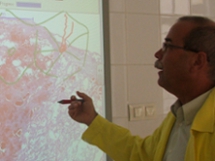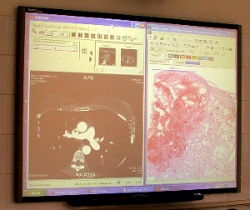Starting in September 2011, students will have the opportunity to learn additional information about autopsies using interactive smart boards at three separate workstations. The touch-screen projector displays the entire medical history and all clinical test results (e.g. lab tests, CT scans, histological sections) of the patient lying on top of the autopsy table. This technology is unique in Hungary and has been used in the 1st Department of Pathology and Experimental Cancer Research for one year; as a result of the current expansion, 60 to 80 medical students will now be able to participate in the practical training at the same time.

Department Director Prof. András Matolcsy emphasised that this 21st century technology is a tremendous step forward in medical education: “Until now, students had to learn about each individual element of clinical history separately, but they will now have the opportunity to assemble the tiny mosaic pieces into a complete picture.” For example, the histological sections of previous biopsies of a patient may be called up with a simple click in order to find out what condition their doctor had suspected on the basis of the examination; immediately after, the subsequent changes in the patient can be viewed “live” on the autopsy table. This highly supports the development of medical thinking, as one can clearly see the outcome of various clinical symptoms and clinical interventions.
 Another development, which may also be realised in the near future, supports not only education, but the professional consultation of clinicians and pathologists as well. Ideally, every doctor should be present during the autopsy of their patient, since this is a direct way to evaluate the accuracy of the diagnosis and the suitability of prescribed treatments. “The pathologist’s job is to hold a mirror to the clinician,” in the words of Dr. Matolcsy. In the daily routine however, this practice is made difficult by, among other things, the distance between some of the University’s departments. As an innovative solution, a real-time video connection will soon be built between the 1st Department of Pathology and Experimental Cancer Research and several other departments. With the aid of a state of the art camera system placed in the autopsy room, the deceased patient’s doctor(s) will have the opportunity to follow the autopsy as it happens, thus enabling a joint discussion to take place between all professionals involved, without the need to be physically present in the autopsy room.
Another development, which may also be realised in the near future, supports not only education, but the professional consultation of clinicians and pathologists as well. Ideally, every doctor should be present during the autopsy of their patient, since this is a direct way to evaluate the accuracy of the diagnosis and the suitability of prescribed treatments. “The pathologist’s job is to hold a mirror to the clinician,” in the words of Dr. Matolcsy. In the daily routine however, this practice is made difficult by, among other things, the distance between some of the University’s departments. As an innovative solution, a real-time video connection will soon be built between the 1st Department of Pathology and Experimental Cancer Research and several other departments. With the aid of a state of the art camera system placed in the autopsy room, the deceased patient’s doctor(s) will have the opportunity to follow the autopsy as it happens, thus enabling a joint discussion to take place between all professionals involved, without the need to be physically present in the autopsy room.
This development project was made possible by the Semmelweis Skill Centrum grant.
Pálma Dobozi
(Translated by Gina Gönczi in collaboration with the 1st Department of Pathology and Experimental Cancer Research)


